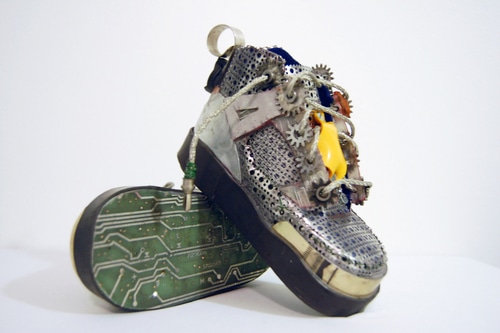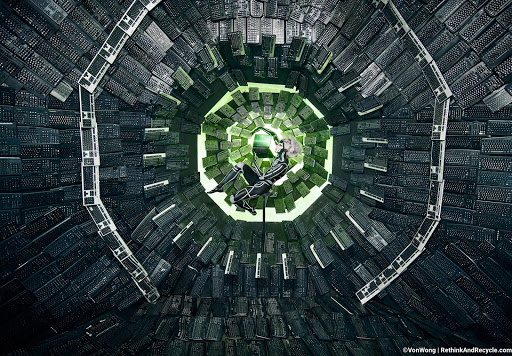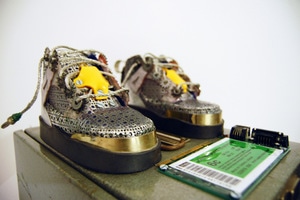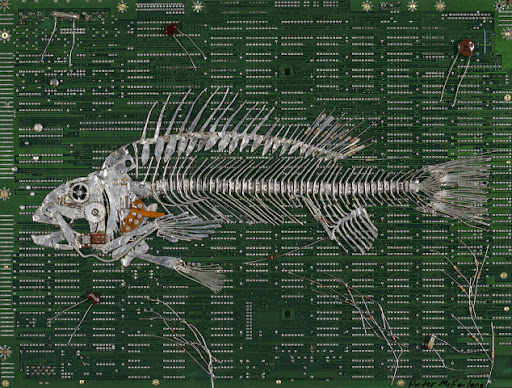E-waste could have horrible impacts on our environment and, eventually, our health, but some artists are doing their part by creating e-waste art.
You wouldn’t expect the word “e-waste” to inspire creativity, but artists all over the world are doing just that–being creative. E-waste art is exactly what it sounds like: creating art by recycling electronics that are no longer in use.
The goal of these artisans is to raise awareness of e-waste and how to reduce it. By bringing awareness to the increasing rate of e-waste and its hazards, these artists are doing what environmental activists have been trying to do for years: get more people to recycle their e-waste.
“All we needed was to convince more people to recycle, so we decided to build something that people would hopefully want to talk about,” said photographer and artist Benjamin Von Wong.
It’s a lot easier to start a conversation about an art piece than by throwing random facts and figures at people. These artistic conversation starters just might be the best way to increase the rate of recycling.
While e-waste art is educational and beautiful there are many other benefits to recycling your unwanted electronics.
The Benefits of Recycling Your E-waste
According to Von Wong, 142,000 computers are thrown away in the United States every day and only 15 percent of it is recycled. That averages to about 44,055,500 computers each year are being thrown away and not recycled. In order to bring this issue to life, Von Wong used 4,100 pounds of old computer parts, which was the average amount of equipment that Americans waste in their lifetime.
More than 5 million tons of electronic equipment in the U.S. is recycled every year, according to the Institute of Scrap Recycling Industries (ISRI). Which means that that waste is not taking up space in our landfills.
While the various components in our electronics are safe when in use, once they end up in a landfill they become biohazards. The toxins in our e-waste can seep into our soil or bodies of water and create a health hazard for people and the environment.
Recycling e-waste also decreases the amount of money that manufacturers spend to create new products. And the best part is that these recycled parts came to be used over and over and over again and never lose their usefulness.
For example, did you know that one metric ton of electronic scrap from personal computers contains more gold than recovered from 17 tons of gold ore?
According to ISRI:
Recycling reduces [our] energy consumption and the emission of greenhouse gases that contribute to global climate change, while helping to maintain a steady supply of raw materials for the U.S. and global economies.
We can seriously reduce our carbon footprint by recycling e-waste. It’s that simple.
E-waste Art
Artists all over the world are taking things that others may perceive as junk and turning it into works of art.
Benjamin Von Wong
In 2017, Von Wong’s eyes were opened to the magnitude of e-waste people produce over their lifetime. After speaking to a Dell representative, he realized that one of the biggest challenges that the company faced with recycling e-waste was just getting people to recycle and raising awareness.
That got his creative juices flowing and he pitched an idea to Dell in order to raise awareness: using the past to fuel the future.
Dell uses lots of recycled parts in their computers, so Von Wong wanted to show how our past waste can help create a new generation of computers.
Gabriel Dishaw
Sculptor and upcycler Gabriel Dishaw makes a living creating art by reusing waste. He brings everything from shoes to our favorite pop culture characters to life using upcycling materials.
According to Dishaw, “My passion for working with metal and mechanical objects has been essential in the evolution of my art. It provides me an avenue to express myself in a way that brings new life to materials such as typewriters, adding machines and old computers – technology that would normally end up in a landfill.”
He states that his mission is to create a dialogue in order to help people find sound ways of repurposing their e-waste.
Peter McFarlane
Peter McFarlane creates e-waste art using old circuit boards. He does everything from sculptures and paintings to even scrapescapes, which is “a marriage between the circuit board paintings and sculpture.”
Peter says, “To me, waste is just lack of imagination. This belief carries beyond the boundaries of my art production and permeates most aspects of my life.”
His goal in his art is to challenge the viewer’s expectations and their perceptions by using recycled objects. He strives to create e-waste are that is unsettling the viewer. He hopes to make the audience look closer, and think harder about recycling electronic waste.
Recycling Your E-waste
Wondering how you can do your part? Recycling your e-waste is as easy as finding an established e-waste recycler like Great Lakes Electronics.
We have years of experience performing environmentally friendly recycling of electronic products, including computers, circuit boards, telephone equipment, and communications systems.
Great Lakes Electronics offers secure destruction of personal, sensitive, proprietary, or classified information that may still be on your hard drive. This eliminates the threat of a security breach and identity theft completely.
To find out more contact us or call us at 888-392-7831.




